“Heart of Stone”
Written by Ira Steven Behr & Robert Hewitt Wolfe
Directed by Alexander Singer
Season 3, Episode 14
Production episode 40512-460
Original air date: February 6, 1995
Stardate: 48521.5
Station log: Odo and Kira are on their way back from Prophet’s Landing in the Mekong when they pick up a distress call from a Lisseppian supply ship that’s under attack by a one-person Maquis ship. Kira and Odo go after the latter, which crash lands on a moon orbiting a gas giant in the Badlands.
Nog informs Sisko that he’s had his bar mitzvah—er, that is, his Ferengi Attainment Ceremony, which means he’s now an adult, and he must become an apprentice. He chooses Sisko as the person to whom he wishes to become apprenticed—he wants to join Starfleet. Sisko points out that handing him a bribe (a bag full of latinum) won’t cut it. He has to apply to Starfleet Academy, get in, and graduate, and before he can do any of that, he—as a non-Federation citizen—has to get a letter of reference from a command-level officer. Like, say, Sisko, who says he’ll think about it. (Sisko tries to give the bribe back, but Nog insists on him keeping it.)
Kira and Odo have checked the wreckage of the Maquis ship, and there’s no sign of the pilot. Weather conditions on the surface of this seismically unstable moon are not survivable for more than a few minutes, so they check a series of underground caverns. After the third quake, they decide to split up, search for twenty minutes, and then abandon the moon before they get killed.
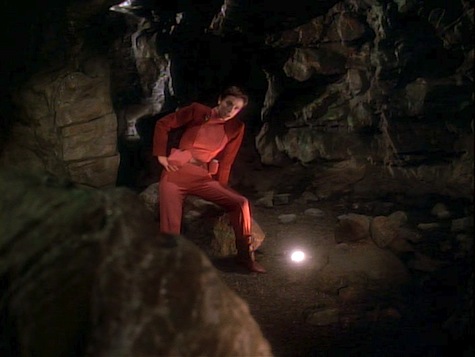
A few minutes after they split up, Kira calls for Odo on his combadge—her foot got stuck in something. Tricorders are useless on this moon, but from what Odo can see, some kind of crystal has engulfed her foot and is spreading. She can’t slip her foot out of her boot, and Odo’s attempts to smash it with a rock fail. Kira tries to phaser the crystal off, but the weapons fire makes the crystal grow up to her knee. There’s too much interference to contact the runabout, so Odo has to go on foot. (Kira promises not to go anywhere while he’s gone.)
Rom and Nog are fixing the replicator power supply for the bar. Rom warned Quark that it might burn out if he didn’t do regular maintenance, but Rom quickly wilts under Quark’s anger. When Rom goes off to get a part, Jake comes in and tells Nog how amused he was by the joke Nog played on his Dad—but Nog angrily insists that it wasn’t a joke. He wants to join Starfleet—but he won’t explain why to Jake, saying it’s personal.
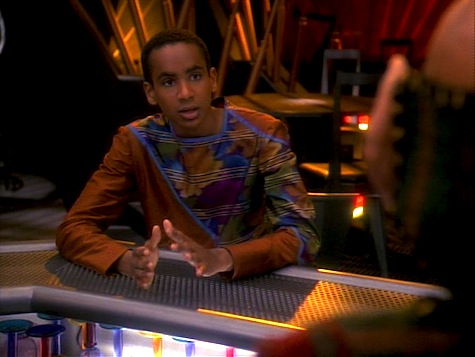
Odo is unable to get a transporter lock from the Mekong directly, either. He sends a communications probe with a distress call, but it could be at least two days before there’s a reply. On his way back to Kira, he hears phaser fire. When he arrives, there’s a scorch mark on the rock behind her, and Kira says that she saw their Maquis prey briefly, and they exchanged weapons fire. The crystal is continuing to move up her right leg and is making progress up her left.
Nog sees Sisko on the Promenade and asks if he’s made a decision, and Sisko admits that he doesn’t consider Nog an ideal candidate—not due to his being a Ferengi, but because of his poor grades back when there was a school, not to mention his run-ins with the law—but he all but begs for a chance to prove himself. So Sisko has Dax assign him to inventory in a cargo bay. It was already inventoried recently, so they’ll know just how good a job he does.
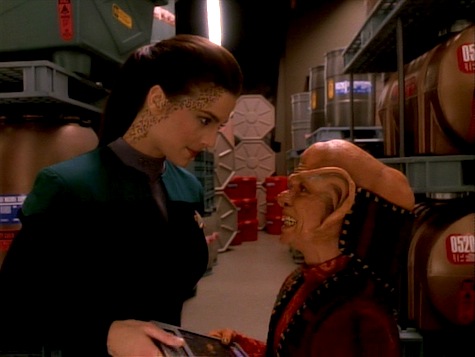
The crystal is now up to Kira’s waist. Odo is frustrated by his inability to analyze it with a tricorder. Odo suspects that the Maquis terrorist deliberately chose this moon because it neutralizes transporters, combadges, and tricorders. Odo comes up with a plan based on a criminal activity report from Starfleet Security that he read, but it requires him to return to the Mekong, so off he goes, with Kira promising to actually read those reports more often.
Dax assigns Nog to do the inventory, which Sisko wants done by first thing in the morning. Nog promises it to have it before he goes off-shift today. Sure enough, he does it in under five hours with no help, and did as thorough a job as Sisko has ever seen. According to Dax, he even found some things they missed on the last inventory.
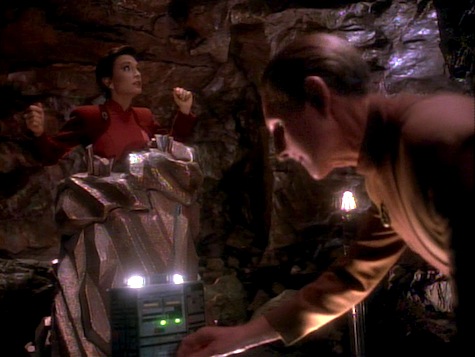
A massive quake hits the cavern, forcing Odo to form a canopy to protect Kira and the generator he’s cobbled together to try to shatter the crystal—which is now up to Kira’s chest. Unfortunately, Odo is unable to shatter the crystal, even after working through the entire harmonic frequency. The crystal gets up to Kira’s neck, and she’s having a hard time talking. Eventually, Kira tells him to take the runabout and get off the moon before another tremor kills them both. She even makes it an order, but that just gets Odo to resign his commission. He won’t abandon her no matter what, because he’s in love with her. Kira shocks Odo by replying that she’s in love with him, too.
Sisko tells Nog that he’s not Academy material, and Sisko won’t put his reputation on the line for someone who won’t cut it. Whatever scheme he’s involved with, Sisko won’t be a part of it. He deliberately provokes Nog to get him to say why he wants to be in Starfleet. Nog finally admits that he doesn’t want to become his father. Rom could’ve been a chief engineer on a starship, but he went into business like a good Ferengi, and all it got him was to be Quark’s lapdog. Nog wants something more for himself—he’s got his father’s hands and his uncle’s tenacity and he thinks he can be a good Starfleet officer. Sisko, impressed with his speech, agrees to send the letter.
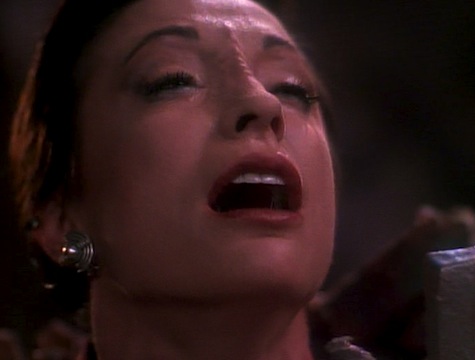
Odo has realized that something’s wrong with the entire scenario. He knows that Kira doesn’t love him, and that makes him realize that there are other problems with the situation. Eventually, “Kira” reveals her true face: the female changeling. She was also the Maquis terrorist, and she contrived the entire situation in order to find out why Odo stayed with the solids. She figured it had something to do with Kira, and the conversation they had while “Kira” was “trapped” proved her right. She beams away, and Odo finds Kira locked in a box (which explains how the female changeling got her hands on a working combadge and phaser). As they return to DS9, Odo tells Kira only that he saw through it because of a slip of the tongue—“nothing important.”
Quark tries to forbid Nog from joining Starfleet, but Rom says that, while Quark runs the bar, Rom makes the decisions about his son—and he wishes Nog good luck. Quark thinks they’re both insane.
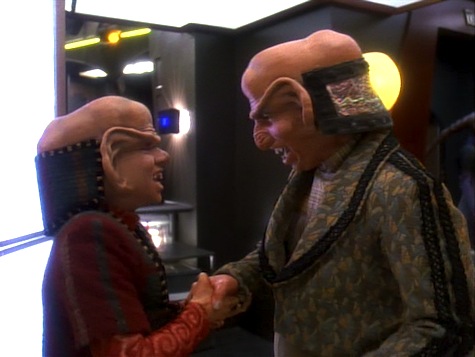
Can’t we just reverse the polarity?: Rom tells Quark that the replicators might break down if he doesn’t do regular maintenance. To Quark, the “might” means he doesn’t have to actually do regular maintenance.
The Sisko is of Bajor: Sisko is utterly confused by Nog’s desire to join Starfleet (echoed by Jake and Dax). His reluctance to recommend him isn’t because he’s a Ferengi, but he plays on the traditional prejudice against Ferengi in order to provoke Nog to tell him why he wants to join.

Don’t ask my opinion next time: In the teaser, Kira and Odo have an amusing kind-of-an-argument in the runabout where Odo is cranky (well, crankier) because Kira didn’t consult him before turning down a dinner invitation. Of course, she knows Odo doesn’t eat and hates socializing with people he doesn’t know, but Odo still wanted to be asked, first. The argument is delightful, in part because it becomes so tense, but Kira can’t help break a smile at Odo’s outraged curmudgeonliness.
Preservation of mass and energy is for wimps: We learn the origin of Odo’s name: the Cardassian word for “nothing” is “odo’ital,” which was how the sample container he was put in after being found was labeled by the Cardassian overseer (Dr. Mora called it “unknown sample,” but that was how the overseer translated it into Cardassian). After he was discovered to be sentient, the Cardassians dubbed him “Odo Ital,” as if it were a Bajoran name.

Rules of Acquisition: Nog states that Rom is a mechanical genius, as seen in “Necessary Evil,” and which will continue to be a theme going forward, but he doesn’t have the lobes for business, and Nog fears that he doesn’t either, hence pursuing a career in Starfleet.
We get Rule #18: “A Ferengi without profit is no Ferengi at all.”
Victory is life: A reminder of how awesome the Dominion is: all by herself, the female changeling is able to fake a Maquis attack and lure Kira and Odo to the moon, subdue Kira and take her combadge and phaser, and then beam out from a world whose interference makes it impossible for Starfleet transporters to function.
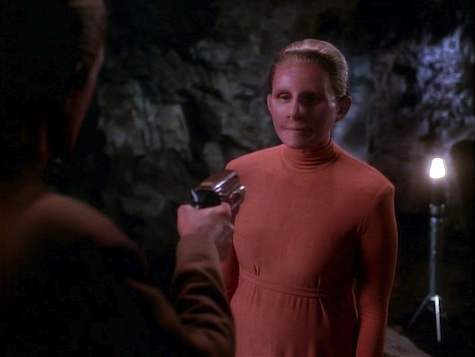
No sex, please, we’re Starfleet: Odo finally admits out loud that he loves Kira, something that’s been fairly obvious but never stated (except by Lwaxana Troi in “Fascination”). Of course, he admits it to the female changeling rather than the real Kira, but we live in an imperfect galaxy…
What happens on the holosuite stays on the holosuite: O’Brien has been taking Odo kayaking on the holosuite. Odo enjoys it, though O’Brien does all the singing (“ancient sea shanties” such as “Louie Louie”).
Keep your ears open: “Of course it’s your fault. Everything that goes wrong here is your fault. It says so in your contract.”
Quark blaming Rom and providing eternal justification for same.
Welcome aboard: Salome Jens establishes herself as a recurring character by reappearing as the female changeling—though she agreed not to be listed in the opening credits so as not to spoil the surprise of her appearance. The only other guests are also recurring regulars, Max Grodénchik as Rom and Aron Eisenberg as Nog.
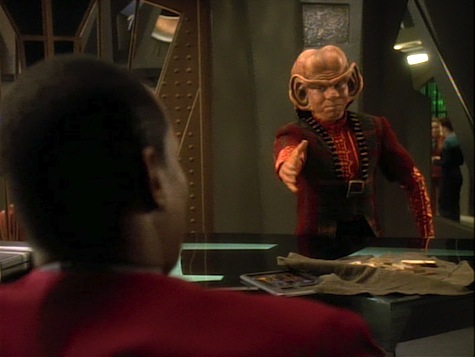
Trivial matters: One of the inspirations for this episode was the Ken Kesey novel Sometimes a Great Notion and its film adaptation. Another was Shakespeare’s Twelfth Night, from whence comes the title.
In “The Search, Part II,” the female changeling said that she might visit Odo in his world to see what was so appealing about it, which she fulfills in this episode (somewhat backhandedly).
This episode has the first mention of Ensign Vilix’pran, who will be mentioned again in “Apocalypse Rising” and “Business as Usual,” as well as the novels Section 31: Abyss by David Weddle & Jeffrey Lang and Rising Son by S.D. Perry. However, he is never actually seen (not even in the novels).
O’Brien’s love of kayaking was first seen in TNG’s “Transfigurations.”
Apparently, non-Federation citizens need a reference from a command-level officer in order to be considered for admittance into Starfleet Academy. This would apply to any Bajorans in Starfleet also, though probably not to Worf (he was adopted by two Federation citizens, and so probably is a Federation citizen himself).
Walk with the Prophets: “I would be proud to have a son in Starfleet.” Earlier this week, we were talking about A plots and B plots, and here’s a case where they complement each other nicely. Both have characters expressing heretofore unexpressed heart’s desires (though in Odo’s case, only unexpressed verbally), and both revelations are problematic. Nog’s admission is met with surprise and suspicion and disbelief—to the point where his best friend thinks it’s a practical joke—and Odo’s remains a secret to everyone except for the female changeling precisely because he fears Kira’s response.
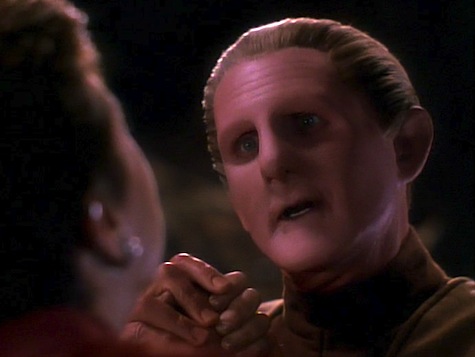
Both revelations are of even more import because they will continue to have an impact on the series moving forward. Nog’s Starfleet career will be a delight to behold (though not always a joy, as we’ll see in “The Siege at AR-558” and “It’s Only a Paper Moon”), and Odo’s relationship with Kira will continue to develop as well. In addition, we get a reminder of the Dominion threat as something other than an abstract notion—it’s been wholly in the background since “The Search, Part II”—and what’s especially notable is that this entire ruse was done for the sole purpose of finding out more about Odo. The Founders’ desire for Odo to return to the Great Link is more important than any political gain or military conquest for the Dominion, and we’re reminded of that here.
But it’s the ostensible B story that has real weight here. Nog’s sudden desire to join Starfleet seems to come out of nowhere—though that is made a plot point—but it’s made totally believable by two scenes. The first is when Quark kicks Rom when he’s down, and Rom’s sole response is to say, “You missed a rib!” which nicely sets up the heart of the episode, when Nog finally explains himself. Aron Eisenberg’s performances on the show up to this point have been hit or miss—he sometimes overenunciates to the point where it can get in the way of his actual acting—but he absolutely nails every scene he’s in here, from his eagerness with Sisko and Dax to his anger at Jake to his frustration with Quark to all of those emotions and more playing out in the scene in Sisko’s office. Eisenberg himself has cited the latter scene as his favorite piece of his own acting, and he’s right: it’s a tour de force of emotional anguish and self-realization. While Sisko and Nog jointly quote Rule of Acquisition #18, it’s Rule #9 that applies here: “Opportunity plus instinct equals profit,” only in this case the “profit” that Nog gets is a shot at a Starfleet career.
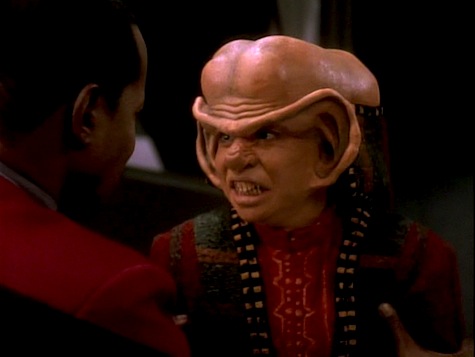
Avery Brooks plays it just as well, goading Nog into giving him the real answer, and seeing the anguish on Nog’s face, the fear in his voice, the very real possibility that he’ll become as beaten-down as Rom, and watching as his facial expression modulates slowly to one of respect and understanding. Best of all is the effect it has on Rom: for the first time that we’ve seen, Rom defies Quark, giving Nog his blessing to attend the Academy.
Eisenberg’s heartfelt anguish is matched by that of Rene Auberjonois when he bares his soul to the person he thinks is Kira. I have to admit to having never entirely being able to get my arms around the notion of Kira and Odo as a couple. For starters, they had such a good, strong, sensible friendship—the two anti-authoritarians surrounded by hidebound Starfleet morons—that adding a romance just felt, I dunno, lazy? Obvious? Pointless? Plus, while I’m all for interspecies romance, she’s a humanoid and he’s a pile of goo…..
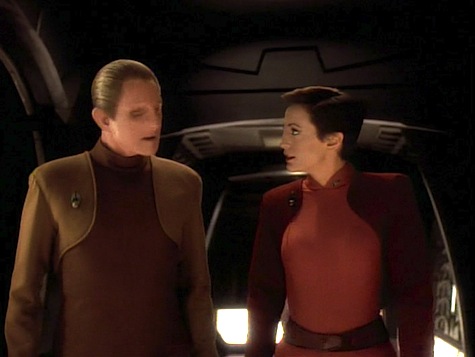
But the only reason it ever worked is because of how well the actors sold it. And in this episode in particular it’s not only how well Auberjonois sells it, but how well Nana Visitor doesn’t—and it’s just the last in a line, as Visitor’s entire performance is just a little off-kilter the entire time that she’s really the changeling (which is as it should be). It’s nothing actively and obviously wrong, but it’s a bunch of little things, which have a cumulative effect on Odo (particularly once he gets the bucket of ice-water that is “Kira’s” admission of mutual love).
Warp factor rating: 8
Keith R.A. DeCandido has autographed copies of many of the books and comics he’s written for sale. They make dandy holiday gifts. Information, including several new books dug up in the garage recently, can be found here.










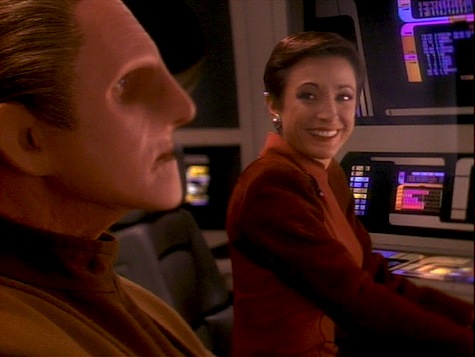
There are several conceptual problems with the episode that you’d think would work against it. Nog’s out-of-the-blue career ambition is one. Another is the whole situation on the planetoid, which is one enormous, ongoing plot contrivance — it just conveniently happens to neutralize every form of technology. Another is the awkwardness in appearance and staging of a story that centers on Kira standing in one place getting covered by stuff — it’s really kind of a silly premise, and the revelation that it’s staged doesn’t help much.
But the episode works because of the strength of the character writing, particularly in the Nog subplot. I particularly loved seeing Rom stand up to Quark on behalf of his son.
Although I’m not quite as fond of the Odo-Kira romance thing either. I don’t like the idea that Kira is the only reason Odo stays on DS9. Surely there’s his sense of duty, his other friendships, his need to keep an eye on Quark, etc. And the whole idea of a theoretically nonhumanoid, profoundly alien, and strictly speaking genderless being having a human-style romantic infatuation is just too anthropomorphic for my tastes. I know, I know, TV audiences want characters they can relate to, but I’m the sort who’s more intrigued by characters whose psychology and responses are alien. I think there are ways to make alien characters relatable without domesticating them to the point that their exotic attributes are lost.
Of course, TV writing staffs tend to write to the strengths of the actors, and it was the chemistry between Auberjonois and Visitor that led them to conceive of the romance. Still, it strained my suspension of disbelief somewhat.
Your last line in that penultimate paragraph hits on the reason for my reluctance to buy into the Kira-Odo relationship: he’s a pile of goo. I believe that Kira and Odo have an awsome friendship, that they care deeply for each other, and they might die for one another. I can even believe that caring about Kira is the reason that he stayed on DS9 rather than returning to the Changlings. But I don’t believe that he is “in love” with her in the human sense–with all the caring, desire, and jealousy that implies. Why does a pile of goo sexually desire a humanoid female? Why would he be jealous of her other partners? Given how many of those feelings are biological, I don’t think it makes sense.
That aside, though, my dislike of the Kira-Odo romance in general doesn’t really affect my feelings about this episode, since romantic love didn’t enter into it too much. I also loved the Nog half of the episode, especially when Sisko finally relents and promises to give him his chance.
the replicators might break down if he doesn’t do regular maintenance. To Quark, the “might” means he doesn’t have to actually do regular maintenance.
I’ve had CEOs like that!
Shouldn’t Odo have a name the Changelings would’ve given him before they sent him and the others out into the universe? Every time the female changeling calls him Odo, I’m thinking “you do know you’re referring to him as nothing, right? Don’t you have an actual name that you associate with him?” I haven’t seen the entire series yet, but I’ve seen enough interactions between Odo and the changelings that it doesn’t appear that he has a previous name.
@@.-@: Why would blobs of goo that communicate by merging into a single group consciousness have any kind of names as we understand them, let alone ones we could pronounce?
Nog’s speech here is actually one of my favourite moments in all of ST. Since introducing them as gibbering monkey-like buffoons in TNG, it had taken a while for ST to turn the Ferrengi into a believable race, and most of that was down to Quark. But it is Nog, in this moment, that completes that transformation through his realisation that he will never be anything special in the Ferrengi world, but that he just might have that chance in the Federation world. It’s a credit to the actor and to the writers that they pull that moment off so brilliantly and so believably.
I noticed something was up when the morphing crystal behaved more like a changling shapeshifting than a crystal growing. I’m glad they thought of using harmonic frequency to shatter the crystal. That’s the first thing I would have done (er, that is, once I realized that shooting it with a phaser wouldn’t work…) And then when the “crystal” seemed to actively mutate, I thought that the crystal might be something like the key in “Vortex” (which I thought was weird because it was on this side of the galaxy, not the GQ, but I supposed if Odo could get here from that far…)
Even with all these clues, I never would have suspected that Kira herslef was a changeling. (If Real!Kira was locked in a box, and the Maquis was also the changeling, then who was she shooting at?)
Also, a guest star allowing herself not to be listed in the opening credits so as to maintain the sense of surprise? Oh, how I wish more actors would do this. Seriously, how many “surprise reveals” are ruined by the opening credits these days, huh?
Nog joining Starfleet was an interesting story, though unfortunately it had been spoiled for me already by this very rewatch. I realize this is supposed to be a “re”-watch, but please realize that there are first-time watchers, too. (That’s mostly to the commenters, not to KRAD, since he does a nice job about being delightfully vague about future episodes. Also, to CLB, thanks for your comments last episode. Thanks for not spoiling, and I’ll definitely look forward to it!)
P.S. I recently stumbled across KRAD’s and CLB’s Spider-Man novels (“Down These Mean Streets” and “Drowned in Thunder”, respectively), and picked them up, both because of my love of Spider-Man, and my recognition of those names due to this rewatch, and may I say, both novels are Excellent.
I never really much liked the A-plot in this one, possibly because Kira is so off for most of it. The reveal that it’s actuallly the female changeling explains why, but it doesn’t really take away the meh-ness induced by it in the first place.
If Aron Eisenberg had been opening credits cast, the B-plot may well have been the A-plot. It’s a lot more solid and sets up something that will carry throughout the series, even having important effects. And as Ashcom says @6, this is the moment when the Ferengi really come into their own and develop serious depth.
@7: “I noticed something was up when the morphing crystal behaved more like a changling shapeshifting than a crystal growing.”
I just attributed that to the limitations of the morphing effect at the time.
“(If Real!Kira was locked in a box, and the Maquis was also the changeling, then who was she shooting at?)”
No one. She shot at nothing and made Odo think she’d shot at the Maquis.
“P.S. I recently stumbled across KRAD’s and CLB’s Spider-Man novels (“Down These Mean Streets” and “Drowned in Thunder”, respectively), and picked them up, both because of my love of Spider-Man, and my recognition of those names due to this rewatch, and may I say, both novels are Excellent.”
Thanks! I hope nobody minds if I plug GraphicAudio’s full-cast audiobook adaptation of Drowned in Thunder, which just made AudioFile Magazine‘s Best Audiobooks of 2013 list in the Sci-Fi, Fantasy & Audio Theater category. The GraphicAudio folks tell me they’re hoping to do more Marvel novel adaptations, so I’m hoping they’ll do Mean Streets too (and maybe Jim Butcher’s The Darkest Hours — and I think there was a fourth Spidey novel in the Pocket Star series, but I never read that one).
The fourth Spidey novel in Pocket Star’s line was Requiem by Jeff Mariotte.
—Keith R.A. DeCandido, trivia hound
Double post, sorry…………
Well, in-universe Odo’s name may come from the Cardassian for ‘unknown’, but outside… the guy is caught between two worlds and systems of living, always an outsider wherever he goes, never uses a weapon and I’m not sure he ever takes anything with him when he goes anywhere, anything beyond a PADD, anyway… I’m sure these parallels must be specious and the coincidence of names between the founder of Odonianism and the constable a mere coincidence because half these properties weren’t known when the show started and Odo was given his name, but still it’s a nice piece of pareidolia.
Alternatively it may be further proof that when you have the flu your mind goes a bit crazy spotting unjustified parallels. :)
One point: there is no evidence that the female changeling does this ‘all by herself’. Not only do we never get any evidence that the female changeling is the same person every time we see her or even a single individual in any sense (she could be a committee, or differently reconstituted every time: she even says, much later, “the ocean becomes the drop”), but there could be a hundred Jem’Hadar right around the next bend. With no working sensors of any kind, how would we know? Sure, they’d have to get through the wormhole, but since Founders can clearly slip through, it seems unlikely they can’t infiltrate other things through as necessary. Perhaps not in large numbers, but enough for a mission like this. It’s not like any expense would be spared.
I thought for a while that this episode also shows that despite their loathing of solids and self-imposed isolation the changelings are hot stuff at social analysis and theory of mind (which probably helps when running a major empire with the overriding goal of minimizing turmoil) — but it doesn’t. The only entity the female changeling (let’s call her ‘Salome’) does any sort of theory-of-mind-reading on here is Odo — and having already linked with him a couple of years ago she has a better mental model of him than any of us can ever hope to have of each other. Telepaths having good mental models of those whose minds they read is not a surprise, and doesn’t really help when running an empire most of whose members you cannot read (because you can’t link with them).
I never really bought into the Kira an Odo romance. Friendship and love maybe but not in the romantic sense. Why would Odo feel this way toward Kira? I realize that Odo spent most of his life in a lab surrouded by scientist and guards but didn’t any of them talk or visit with their wives or girlfriends so Odo would have a clue what to do if he wants to persue a relationship on a different level. I don’t think this is ever addressed. Odo Loves Kira got it. Now what?
I like the Nog story a lot and how it continues to grow thought the series run. The final scene in the office is one of the best Nog scences yet.
A couple people have commented that it doesn’t make sense for Odo to ‘love’ Kira. I am perplexed by this attitude.
He is clearly a sentient being. He thinks, he feels, he has friends. What is so special about ‘love’ that it somehow can’t be grokked by someone just because they don’t have a stable bone structure? Sure, Odo is an alien but there are all kinds of aliens in the ST universe. I don’t see why his alienness is so radically different than the many others.
This is not to say that I think it’s clearly the case that love is a universal phenomenon, that everyone would experience it in the same way that we do, or anything like that. I think it’s just as bad to assume that the human experience is the only possible way to live as it would be to assume that the human experience is so unique that other forms of life could never grasp it. But one of the defining features of Star Trek is that it errs almost exclusively in the direction of a fundamental equality of life.
So I would definitely have been interested to see a different version of Odo, one that treats his differences as genuinely incommensurable in terms of emotions and attitudes. But that’s not the Odo they gave us. His arc is not simply a repetition of Data’s attempt to become human, but it’s not completely different, either.
@17: Love among humans is a matter of biochemistry, instinct, and psychology evolved over millions of years to promote procreation and interpersonal bonding. It isn’t logical that a nonhumanoid alien would have the same behaviors or be capable of responding to the same stimuli. The members of a given species have behavioral and pheromonal cues that promote attraction, desire, or bonding between them, but those cues generally don’t have the same effect on members of other species — which is why you don’t see humans falling madly in love with cows or parakeets. (Sexual paraphilias involving animals are another matter; I’m talking about the emotion of romantic love.)
Besides, it’s just so damn heteronormative to have an asexual alien take on a superficially male appearance and then fall in love with a woman. The same problem arose with Q — even though his human appearance was totally arbitrary, they still wrote him as if he were a heterosexual male, having him flirt with Vash and Janeway and eventually giving him a Q girlfriend that he had a baby with.
I sort of get why Odo might love Kira, but I always thought it should be a strictly platonic relationship. For Odo, who grew up as a lab specimen and has never really had any sort of relationship with anyone, he could very easily find in Kira a fantastic best friend. Another outsider, another seeker of truth and justice- these are qualities Odo would be attracted to. However, I can’t quite get past the physical issues, since it’s not as if Odo actually has any sexual organs. To him one part of his body would feel the same as any other part of his body. I get how other species can be sexually active with each other, but Odo isn’t even humanoid- he simply takes a humanoid shape (this in an of itself makes sense, since it’s presumably easier to interact with others when they are similar in appearance).
And yes, I agree with CLB that it’s very heteronormative- the one thing that Trek as a whole missed out on was diferent relationships. Enterprise touches on it with Phlox, but we only once see the Denobulan romantic approach with each wife having 3 husbands and vice versa. The only time we see any homosexual relationship is when it involves Trill and only because the symbiont had been involved in a heterosexual relationship when the romance began (Dax-Kahn, Crusher-Odan). More than 20 seasons worth of Star Trek on TV, and not a single non-heterosexual relationship, not even amongst a re-occurring or guest star? It’s a huge opportunity missed.
I don’t see this episode really about Odo and Kira’s relationship. It was doomed from the start (see their first meeting in S02E08 “Necessary Evil).
As mentioned earlier, this episode picks up on some threads from Odo’s previous encounter. It really highlights the differences between Odo and his people. As the series progresses, we will see more examples. It culminates in S07e14 “Chimera,” when Odo is taken to task for not being much of a shapeshifter because he limits himself to humanoid form. However, through much of the series story, we see Odo move away from strict adherence to “justice” and “control” (echoing his people’s base assumptions on these matters) to higher principles related to love/faith (mirroring Star Trek philosophy).
As Odo and his people may not be separate and distinct entities, perhaps by melding with them (seen in the last episode) more than just a physical cure is passed along. Maybe sharing these “flawed” humanoid expressions may reshape the Founders’ worldview.
I am with jonathaninge on this one. As far as I can tell, the character arc for Odo was to be about justice and order, but he moved along to love and faith as things progressed. Maybe he didn’t see things in the lab, but there is a certainty he saw love, loving relationships on Terok Nor even during the occupation.
I see Odo’s return to the Link as being one where he does change the worldview of his people. I see him being a leader (or as much as a leader as a non-distinct entity can be). Part of what he had to learn, and part of why he could never go back was to learn about love, first hand, about humanoid intimacy, first hand, otherwise he would be bringing back a much more limited view of humanoids and their values and expressions.
Besides, and this is one thing I don’t exactly understand, when a shapeshifter becomes something other than a blob of goo, does it not “become” that thing? If Odo became a humanoid, would he not experience what it is to be a humanoid, including emotions?
I don’t really have a problem with Odo/Kira, and their relationship – once it gets going, is the most mature of just about anybody on any Trek. I do have a problem with Kira being stupidly blind to Odo’s desires. She is not a stupid woman – she could have seen it in Season 2 or 3.
@21: “Besides, and this is one thing I don’t exactly understand, when a shapeshifter becomes something other than a blob of goo, does it not “become” that thing? If Odo became a humanoid, would he not experience what it is to be a humanoid, including emotions?”
That’s the ideal, but it’s probably more an aspiration than a reality. It’s certainly not something that comes automatically to Odo. He takes an outwardly humanoid form, but he doesn’t eat or drink, can’t digest food, doesn’t have internal organs or metabolism. So it doesn’t stand to reason that he’d have humanoid hormones or instincts just because he’s outwardly shaped like an approximation of a humanoid.
@18: Sure, I get that love is potentially a uniquely human characteristic in that sense. And as I said, I would definitely have liked if Star Trek on the whole paid more attention to the ways that it colonized the radical difference of potential aliens by making them so commensurable with humanity.
But that is the way that ST works. It takes human experience as always potentially universalizable, if other entities just want to experience it. The Borg can be taught friendship, Data tries to become more human, the Klingons and Ferengi are shown to have the potential to become more like us. In that context, there’s nothing remotely surprising about the way they portray Odo. He is just one among MANY examples in the universe of the belief that environmental conditions and social development ultimately guide one’s sense of self far more than physical programming.
I think we all agree that this tendency to treat the social conditions of late 20th-century liberalism as a universal standard and logical endpoint for sentient existence is not the most interesting aspect of ST.
But I don’t think Odo is a particuarly troublesome example of that problem. While he is not truly humanoid, he has been playing one for a long time. I don’t have any trouble believing that he would begin to take on many of the characteristics of the people around him, even if remains biologically distinct. Which is to say: I can certainly imagine a form of ‘love’ that mimics many aspects of the way human express love while still stemming from very different underlying conditions. That might not constitute ‘romantic’ love in a strict sense, but I think it’s still something distinct from the ‘platonic’ love some folks are talking about here.
@23: No, I’m not saying love is uniquely human. I’m saying that different species have evolved different interpersonal and behavioral cues and thus might not be receptive to each other’s attraction signals and pheromones. Physical attraction and emotional bonding are forms of communication, exchanges of chemical and nonverbal signals that trigger responses. Two different species might both be capable of love and deep emotional bonding within their own species, but their bodies and brains wouldn’t speak the same biological “language” and thus wouldn’t be affected by each other’s signals. My heart races when a beautiful woman smiles and bats her eyelashes at me because millennia of evolution have programmed my brain’s pleasure center to be triggered by that particular visual stimulus. But my brain isn’t programmed to feel the same romantic flutter in response to the seduction cues of a dolphin or an elephant, say. Those species are just as capable of forming loving emotional bonds as we are; elephants are known to grieve for their dead just as we do. But their brains are adapted to respond emotionally to their own sets of visual, tactile, and pheromonal cues which are different from those that stimulate attraction and bonding in humans.
I think it’s definitely possible to feel love for a member of another species, as pet owners can attest. But it’s not romantic love. At most, I can imagine interspecies love being some kind of chaste “courtly” love, operating on a largely mental level.
Then again, now that I think about it, given that Odo’s whole life was defined by mimicry, I suppose that once he realized that he felt some form of love for Kira, he would’ve tried to deal with it and express it in humanoid terms. Not really as consciously putting on an act, but because it was the only way he knew how to cope with it, to find meaning in it.
So I think part of the difficulty here is caused by the fact that we frequently use the single word “love” to describe multiple distinct emotions. I can say that I love to eat ice cream and that I love a good book and that I love my wife, but these are definitely not all the same feeling. Also, the love that I have for my wife isn’t just the kind inspired as a biological response to her obvious physical attractiveness. (Calling that romantic love isn’t really accurate either. I’d say a better word for it would be lust, but there are some negative connotations there that don’t apply.) That’s certainly a part of it, but it’s much deeper than that. It’s love that says I value her happiness, her life more than I value my own (and I value my own quite a bit, thank you very much!). It’s knowing that she values me just as much as I value her.
I don’t have a problem with the idea that Odo can be in love with Kira. It doesn’t have to be a physical / sexual kind of love for it to be real. Nor is it the kind of love one would have for a pet, since that could never truly be reciprocated in the same way. The Greek word agape is probably the right word to use. It’s not a sexual love or a brotherly love or the kind of love you have for something you really, really like. It’s true love. And true love is the only kind that can truly last forever.
@24, I think we have to write off the Odo/Kira love affair as dramatic license/fantasy in the same mould as half human Spock: even though we ultimately came from the same stock (cf Salome Jens’s one appearance on TNG) there is no more reason that humans and Vulcans should be able to interbreed than there is that humans and oak trees should be able to interbreed: actually we’re probably *more* closely related to oak trees than to Vulcans, and I’m not sure Odo’s people are even made of matter: gelatine can’t adjust its mass on demand! Do I share any mating cues with a being that can turn itself into plasma, or fog, or a lead weight? Likely no — but it is possible that this being, already a superb mimic, can learn to *consciously imitate* those cues. Of course this says unfortunate things about the later love affair: Odo never really loved Kira, but merely imitated it for the sake of better getting along with us. Of course, in order to be truly effective, social mimicry has to be believed by the mimic, so maybe this is proof of Odo’s powers of self-delusion?
@26. Nix
I guess the problem we often run into is that it is assumed in SF, and it is lazy, that bi pedal generally human looking races are very likely, depending partly on how attactive they are, to be genetically compatible.
The Oak tree comparison is funny, but somewhat inaccurate, in that the tree, other than being carbon based, shares very little common genetic information. I believe a lab could get involved to make a Human/Vulcan pairing possible, but not a human and a tree.
Science can solve a lot of these issues, but nobody is suggesting that Kira and Odo could have children, or even think about having children, though they would find some way to make it happen if they were high enough one night.
@27: On the contrary, there’s a very easy way for Kira and Odo to have children: They could adopt. There must be millions of Bajoran orphans left behind by the occupation.
I listened to “Louie Louie”. In what universe is this an ancient sea shanty ?
Also, If the founder can mimic a human in sufficient detail to fool Odo, why does she look like Odo in her natural form ?.
Another trope I hate is the.. OK, we have only x hours to live. Now lets stand around and talk about our feelings. (don’t just stand there – do something)
I preferred the Nog storyline.
@29 NigelB
That’s the joke. { /Rainier Wolfcastle }
@29: What exactly do you take objection to in that classification? The ancient part, the sea part, or it being a shanty?
@29: “Also, If the founder can mimic a human in sufficient detail to fool Odo, why does she look like Odo in her natural form ?”
Her natural form is a blob of golden ooze. The humanoid form she adopts was chosen to emulate Odo’s appearance, as a way of showing affinity.
DougL@27, have a look at or something similar. Trees and humans are both very similar in all sorts of ways. We’re both eukaryotes, which means we both share a *huge* amount of fundamental machinery on the cellular level. There are a lot of ways that life, even on Earth, can vary *and is varying now* that doesn’t show up at all if you restrict your view to things big enough to see :) and it seems likely to me that an alien as alien as Odo would be way, way, way out there, if it had anything like DNA at all.
And I am going completely off topic and leaving my audience immobilized in stone. Sorry.
I never really had a problem with Odo’s unrequited love of Kira. First of all, it’s not treated as a sexual attraction (which wouldn’t make sense). Sexual attraction doesn’t universally have to be part of romantic love — speaking of heteronormativity, asexual-oriented people still have romantic relationships.
And, as CLB started to conclude in #24, it’s only natural for a being who is cut off from what would be his normal society to develop substitute emotional attachments based on what he has access to. Heh, amusingly, the Founders are probably right in their opinion that Odo’s love for Kira is indicative of deep psychological neuroses for his species — but they put him in the situation that caused those neuroses, so the way they want to “cure” him rather than being empathetic isn’t exactly admirable.
… Anyway, I LOVE LOVE LOVE the performances of Nog, Sisko, Rom, Quark, and even Dax in this episode, so I’m glad to find out I’m not the only one.
@24 — you realize that in one foul swoop, you’re dismissing ALL cross-species romances in all of Trek? The Orion slave girl would have no attractiveness to human males. Deltans would have no effect on anyone else – Decker and Ilia never happened. Amanda and Sarek, no dice. Worf and Deanna. Lwaxana and Ian. Deanna and Riker. Worf and Dax. Belanna’s parents, Keylehr’s parents. Belanna and Tom. Lwaxana and Picard. Lwaxana and Odo. Lwaxana and Timicin. Wesley and Salia. McCoy and Natira.
From the sublime to the ridiculous, sure. But if your argument is that humanoids from different species are sexually incompatible and cannot possibly attract each other, then you’ve written off 80% of the romances in canon. Whether or not it’s logical or biologically sensible, it is presented to us as fact that that’s how it works in the ST universe.
With few exceptions, gender norms are pretty consistent — males are typically male, females are typically female, with common (or at least similar enough to have fun with) primary and secondary sexual characteristics.
You could argue that this is completely unbelievable, but that’s how the ST universe it built. You can’t say that this ONE relationship is implausible because of this flaw, when dozens and dozens of others — including well-accepted and popular relationships — suffer the same flaw.
The argument about falling in love with dolphins is irrelevant. It’s not just about sentience. There is a certain level of matched intelligence required, a possibility of full communication. Yes elephants and dolphins are ‘intelligent’ creatures, but it’s a different kind of intelligent. You can’t sit down with a dolphin and talk about your day, or what your favourite food is, or whisper sweet nothings to each other. There’s a certain level of ‘equality’ expected for sexual compatibility to arise — not completely dissimilar to how pedophilia is taboo. Human adults and children are the same species, so what’s the problem? The child isn’t of a “level” of equality with the adult, of being able to give full consent for lack of maturity etc. Humans don’t “fall in love” with animals not strictly because we’re different species, different bodies… but because we’re different *inside* those bodies.
The Trek universe conceit is that despite external differences, inside, humanoids are pretty much all the same. Different cultures for sure, but all equivalently “people”. Dolphins are not “people”.
As for heteronormativity, I can easily just chalk that up to the time period and culturally accepted values for TV shows. Just having Dax and her former wife strike up a relationship — *even though* it was ‘softened’ by the fact that Dax formerly loved her as a man — was a *HUGE* deal at the time. Big controversy. A celebrated bold move by a show that always dared to push the boundaries.
By today’s standards it’s pretty tame. But at the time it was huge. To suggest that the sexual world-building of Star Trek is unrealistic because it doesn’t give enough attention to alternate sexualities is asking too much of it too soon, for the time it was in. I mean, there was nothing like that at ALL in TOS… does it get the same criticism?
@35: “But if your argument is that humanoids from different species are sexually incompatible and cannot possibly attract each other, then you’ve written off 80% of the romances in canon.”
My argument is not about humanoids. My argument is about Odo, and more broadly about Q, the EMH, and other intrinsically nonhumanoid and nongendered entities that are written as though they were heterosexual men.
Tto the extent that I’m willing to accept the fictional conceit that humanoids exist in the first place and share common hormonal and behavioral cues (which can be rationalized as a consequence of their common origins), I’d still find it more plausible if the same were not extended to nonhumanoid characters such as Odo. It’s easier to suspend disbelief about a romance between two humanoids than it is about a romance between a humanoid and a sentient Jello mold.
“With few exceptions, gender norms are pretty consistent — males are typically male, females are typically female, with common (or at least similar enough to have fun with) primary and secondary sexual characteristics.”
Which is precisely the failure of imagination I find disappointing. Wouldn’t it be so much more interesting if they explored a wider range of alien sexualities, psychologies, identities, etc.? Trek is sometimes able to make aliens interestingly alien; for instance, the Changelings are a semi-group consciousness with a mutable sense of self. But the franchise, at least in its screen incarnations, has been too timid to do much exploration of alternative sexualities (the best job it did in that regard was with Dax and her history of sex changes). And I think that’s a wasted opportunity for creativity.
And no, it’s not too much too soon. As you say, they did push the envelope with “Rejoined,” but the franchise continued on TV for another nine and a half years after that episode aired, and in that time failed to do anything equally daring again, even as plenty of other television shows around them did so. For a brief moment, Trek took the lead in increasing inclusion, but then it surrendered the lead altogether.
As for the point about dolphins, even if we could communicate clearly on a linguistic level, the point I’m making is that the behavioral cues we’re evolved to respond to are different, and so the triggers for attraction and desire that one species would respond to would go unrecognized by the other. (Although desire isn’t really a problem for dolphins — they’ll hump anything that moves, including humans. But I doubt you’d find many humans who reciprocated their interest.) I certainly think it’s possible for beings of different species to develop strong affinities and bonds; that happens all the time, and if anything we often tend to get along better with members of other species than members of our own. (Dolphins can be quite aggressive, even violent, toward other dolphins, but for the most part they’re quite kind and helpful to humans. And pretty much vice-versa, accidental harm aside.) That’s because we don’t share the same aggression triggers, in the same way that we don’t share the same attraction triggers. But that means that the nature of the relationship is going to be different across species than within a species.
So I’m not saying a humanoid-nonhumanoid relationship should never be written; I’m just saying that it would be more plausible and more creative if it weren’t written exactly like a human relationship.
I am stepping into this kind of late but I did have the same thought – regardless of the presence of interspecies romances between other humanoids (which, according to The Chase, mostly share the same genetic beginnings, so it’s not a stretch to think that the various things controlling sexual attraction and response and mating are somewhat shared)…Odo isn’t a humanoid. Does his species even have sex?
That said, his species DOES certainly seem to form strong emotional attachments, and in fact, he probably has a deep need to be part of some kind of communion, so I can see how in a way that would transfer to Kira and take the form of what he views as romantic love among the solids…perhaps unconsciously emulating them or picking up some of their emotional tendencies.
But yeah, handwaving aside, I may be a little cynical in that the writers probably just wanted to stick a typical romance in there because that’s what people supposedly want to see, and heaven forbid there be female characters that aren’t love interests in some way.
Actually, you know what irritates me about this eposide? We get all these neat insights to Odo’s character (aside from his being in love with Kira), and Kira never actually hears them.
Anyway, I think at the time I watched this I had a lot more to say about Rom and Nog, but I loved it and it made me all squishy inside.
One of my favourite subtle joys of this episode was the way in which Nog excessively/awkwardly kept trying to shake Sisko’s hand. It just felt like such a natural or believable thing – Nog, living among many humans for a few years and befriending Jake, has started to learn human social behaviours and was eager to try and employ one, even if he couldn’t yet quite gauge the situation. I wonder if it was written in the script or if Eisenberg worked it in.
I loved Nog’s plot, and while I never saw it coming, I don’t think it’s fair to say it came out of the blue. Not every plot twist has to be telegraphed, and he did show willingness to step outside normal Ferengi activities from the very start of the show by befriending Jake.
The Female Changeling really shouldn’t have pulled this trick so soon after Life Support. No wonder Odo saw through it. Quark can’t interfere with Nog’s aspirations because one of the Rules of Acqusition states “never let family stand in the way of opportunity”. I’m surprised the Female Founder didn’t kill Kira, unless she was waiting for the moon’s instability to do that for her. I found Kira and Odo’s coupling easier to swallow than Worf and Troi’s, Tom Paris and B’Elanna Torres, or Chakotay and Seven of Nine. The whole contrived scenario on the moon seems a pointed jab at other episodes where technobabble phenomena conveniently neutralise sensors or transporters, like the TNG two-parter Descent.
@36: I’m jumping into this about three years too late, but I have to say something, on the off chance that somebody happens by and sees this.
I have a somewhat different perspective than most people. I was born with an autism spectrum disorder, specifically what until recently was referred to as “Asperger’s Syndrome.” People like me don’t pick up on social cues the way most people do. Figuring out that sort of thing doesn’t come naturally to me, I have to learn from experience, not unlike the way Odo undoubtedly learned to recognize the social cues of the humanoids who raised him.
Ironically, I’ve explained my experience with behavioral cues as, “like being on an alien planet where you don’t speak the language.”
I’ve gotten better at recognizing certain social cues just from putting myself in those (very uncomfortable, for me) social situations where I can observe them. But I still don’t recognize if somebody’s flirting with me unless they literally tell me, “I’m flirting with you.”
I felt like I needed to say this, to point out that there are humans, let alone aliens or sentient piles of goo, who are “biologically” illiterate, so to speak. The sort of biological and behavioral stimuli that have been discussed here as being intrinsic to romantic attraction are completely lost on me. I experience romantic attraction solely through an attraction to another person’s PERSONALITY, regardless of their sex or gender identity, and completely separate from sexual attraction, which I can’t honestly say I’ve ever felt.
All this is a roundabout, long-winded way of saying that I don’t think love needs to have anything to do with biology, and discounting the possibility that someone, even if that someone is a puddle of goo, could fall in love with the personality of a completely different form of life is rather narrow-minded.
@41/Denise L.: Thank you, that’s an intriguing perspective. In defense of my position, though, I did say that I believed it was possible for beings of different species to feel love toward one another; I just didn’t find it plausible to portray it as being identical to a heterosexual attraction between a man and a woman, which is what the show did. They took what should have been a very novel, unusual form of loving bond and wrote it according to standard heteronormative tropes, and that is what I had a problem with. Not the fact that the love existed, but the unimaginative, conventionally gendered mold the writers forced it into. So we’re not really that dissimilar in our views. I think we both would have been more satisfied if Odo had actually been written the way you suggest — as an intrinsically asexual being that was unresponsive to humanoid physiological attraction cues, yet nonetheless loved Kira on the level of personality alone. That would’ve been much better than writing him as just a man who had the hots for a beautiful woman and wanted to kiss her.
@42: Thank you for responding to me, I didn’t think anyone would see my post.
I guess I don’t have as much of a problem with the way Odo expresses his love for Kira because I interpret it as closer to the asexual attraction I described, but because he’s been raised by heterosexual beings, he only knows how to express it the way he’s seen them express it. It’s not that different from me learning how to socialize, not through instinct like most people, but by watching how others do it and emulating them. But the only “others” that Odo has available to emulate are heterosexual humanoids.
And I know from experience that most humans don’t understand asexuality–they tend to assume if you aren’t interested in sex that something’s wrong with you. Sometimes it’s easier to blend in than to be yourself.
@43/DeniseL: That’s a good point, that Odo might be mimicking what he knows. That makes sense in-universe.
I’m just approaching it from more of a writer’s-eye perspective. I wish the writers hadn’t chosen to push the characters into such a conventional love-story mold, and had instead tried to do something more daring and unusual with the concept of an interspecies relationship with a non-humanoid being. That’s a premise that could be taken in a number of wildly creative directions, but instead we got something far more conventional.
@44: I’m actually a writer, too, or at least I want to be. I’m working on my first novel currently–I’d like to have it ready to start sending to publishers some time later this year. Writing stories is really the one thing that I’ve wanted to do and enjoyed since I was a kid.
When I watch a show, or read a book, watch a film, etc., I try very hard to get inside the characters’ heads and see things from their perspective. I know my limitations. I know seeing things from someone else’s perspective is something I have trouble with, but that just makes me focus on it more. All I can do is look at a situation and say to myself, “How would I feel if this was happening to me?”
Sometimes I’m even surprised that others don’t always go to the same amount of trouble to understand someone else’s perspective.
I’m just speaking in general. It’s actually pretty gratifying to speak with someone as open-minded as you seem to be. I’m used to my opinion being marginalized or discounted.
While the whole situation with the false Kira was a changeling ruse, there were other possibilities Odo could have tried to free her. How about if he changed into a liquid and went through the space between the crystal and “Kira’s” body and used liquid pressure to push her out of the hole? That would have been my solution. We’ve seen Odo’s liquid form expand at will, so it might have worked.
@46/RMS81: The problem there is that the crystal would be more resistant to force than Kira’s body, so trying that would’ve crushed her long before it deformed the crystal enough to allow her to get out. For every action there’s an equal and opposite reaction, remember.
Well, it’s still October 2016,so I guess I’ll post. Why not? :-)
For me, the main “technical” problem with Odo’s attempt to free Kira… oh! I just worked it out as I started typing this. I was going to gripe about how Odo had used a phaser on the crystal (which was also the changeling), to no effect… when changelings aren’t immune to phasers. But… of course it was “Kira” who fired, and she presumably lowered the power on the weapon to something equivalent to “laser pointer” first.
So instead I’ll bring up a different point. I liked the observations of how heteronormative the Star Trek universe has always been. But what really gets me, on watching DS9 again, is how phobic it is about miscegenation… in particular, for Sisko senior and junior. If the love interest is “sufficiently non-human”, then it doesn’t matter. But if she is basically “human with a different nose” – and definitely if she’s human… suddenly these incredibly accepting, cross-species dating heroes keep finding themselves pairing up with dark-skinned partners.
This wasn’t/won’t be an issue with Worf, but he’s “far enough from human” in appearance, I suspect, that it didn’t push so many buttons. But we just saw Jake having that disastrous double-date in Life Support, and Benjamin, of course, had his Jennifer, his Finna (sort of), and one more on the way. It’s been the same with a number of other characters, including minor ones, and it’s really disappointing. At least La Forge was interested in Brahms, but that “relationship” came with its own problems… and then there was Acquiel, of course.
Rewatching these days, this stands out more than most “anachronisms”.
@48/legraf: I think it was established earlier that phasers have to be set fairly high to be dangerous to changelings.
On the interracial-romance issue, it isn’t always about white people’s miscegenation phobias. Some African-American actors prefer to be paired with African-American romantic partners. Eriq LaSalle on ER, for instance, objected to being paired with Alex Kingston in a romantic arc, because the character’s previous, failed relationships in the show had been with black women, so he disliked the implication that his most successful relationship would be with a white character, as if that were intrinsically better. Also, I guess that there’s a perception that African-American families tend to be unstable or to break up, and some actors feel that it’s important for entertainment to show successful, happy black couples to counteract that stereotype. Of course, in theory that shouldn’t matter in science fiction, especially where the actors are playing aliens, but the symbolism of the casting will still be noted by many members of the audience. (Recall how unhappy Avery Brooks was with Sisko leaving his family in the finale, leading to a rewrite where he promised he’d be back one day.) Of course, it depends on the actor and the situation, but that’s just the point — there’s no single blanket cause, since it’s a complicated issue.
@49/CLB: you do make a good point about an alternative, more generous interpretation of the bias we see… and being generous in interpretation is, I suppose, a very “Star Trek” way to be.
I haven’t seen a lot of this series, but I’m wondering if the Changelings aren’t an extremely tactile species. In their natural environment, they’re an ocean. They all flow together, and they’re all aware of each other completely in that ocean. Humans enjoy skin contact, but Changelings can feel each other on every single cell of their bodies. Since they don’t appear to leave very often, they must find it very comfortable, and comforting. Sort of the ultimate puppy pile. :)
Odo, meanwhile, has been terribly isolated all his life. For him it’s probably similar to a human experiencing long-term sensory deprivation, and he may have no idea what it is he’s been needing until the female Changeling links with him. It could be he wouldn’t even be ready to join that ocean just then; it might have been too much too suddenly for him. But the romance he shared with Kira helped him to open up, allow someone to come close, to enjoy being touched by them. Rather than feeling any desire for sex, just the gentle intimacy of touching could be enough for Odo. And that could be one of the things he shares with his people when he finally rejoins them. That solids are capable of loving in that gentle manner, and the love of one of them had helped him rejoin the ocean.
If the Changelings all absorb and accept Odo’s experiences and knowledge, do they absorb that too? Is Kira now loved by a whole ocean? :)
Lisa: That’s an interesting hypothesis. It’s certainly possible…….
—Keith R.A. DeCandido
I just rewatched this episode for the first time in over 10 years and really enjoyed it. One question occurred to me concerning the Nog subplot: Why does he (and, previously Rom) reject the idea of joining the Ferengi space force? They would have just as much need for a good engineer as Starfleet and provide a source of profit that would not depend on personal business sense (outside of picking the best captain to serve under). I can see Rom being bullied into working for Quark, but why doesn’t Nog consider this option?
Nog showed willingness to step outside normal Ferengi activities from the very start of the show by befriending Jake.
@53/Roger: Being an underling in the Ferengi space service would probably be just as lousy a situation as being an underling in any other Ferengi business. I’m sure DaiMons cheat and abuse their crews just as much as business owners cheat and abuse their employees.
If there’s even an actual Ferengi space service instead of just mercenaries doing contract work for the government. Ferengi PMCs.
@56/MaGnUs: Remember, the first Ferengi we met in TNG were officers in their space fleet. We didn’t see a Ferengi civilian until “Captain’s Holiday” late in season 3.
Yeah, but it can be retconned.
It makes total sense to me that Nog would prefer to serve in Starfleet rather than on a Ferengi vessel; he’s seen enough of how his people operate to know that life on one of their ships would be more of the same, just with extra travel, and the Federation can offer him something truly better. Something tells me that serving aboard a Ferengi ship is like something out of The Outer Worlds, with its crewmembers getting nickled and dimed for just about everything in a late-stage capitalist nightmare. Besides, hauling around junk for a few slips of latinum sounds much less exciting than the exploration, diplomacy and combat Starfleet engages in.
Lockdown rewatch, a very good episode, The A plot doesn’t tell us much we hadn’t already guessed about Odo but The first hints about how much the Changelings had infiltrated the Federation are here, they know so much about DS9 station life, more than they could have picked up from the fake Station in the season premiere two parter. René Auberjonois and Nana Visitor are as ever excellent and I remember first time I didn’t see the twist coming. But like others why I love this episode is the B plot, DS9 was blessed with it’s more static location it could bring some excellent recurring characters back most weeks and Rom and Nog are prime examples of this. Both shine in this episode as does Avery Brooks as Sisko as he challengers then sympathies with Nog, it’s all beautifully played. A really good episode that advances two plots lines that would run through future seasons.
I was shocked at how dusty it got in my living room when Rom stood up for this son. It was so good
Hands down my favorite Nog episode. Even though his specific interest in Starfleet wasn’t telegraphed, it fits coming from his contact with Starfleet on DS9, and his friendship with Jake. As well, it fit how whenever Nog desired something, he pursued it with enthusiasm and stubbornness–a powerful combination. When Ben first worried over Jake hanging around Nog, I bet he never thought for a million years that Jake wouldn’t go into Starfleet and Nog would!
My main comment though is on something mentioned above, why the changeling didn’t kill Kira. I think it fits how they presented them, as the Founders stand out as one of scifi’s less cliche’d evil empires. They don’t seem portrayed as being quick to kill “solids”. Sure, when they decided to, they did without compassion or remorse–but only because it suited their purpose. They have their Jem’Hadar soldiers that like to kill, and so are capable of all the force and brutality the Founders find necessary–but are not allowed to rampage freely, being controlled by the Vorta and the White. The Vorta themselves serve to reduce unnecessary bloodshed. A silver tongue backed by the most formidable battle fleet in the quadrant–that can topple planets with no fighting. Especially given that the Vorta tend to offer things quite valuable to the citizens of the worlds they are after. Diplomacy turned to the purpose of conquest–a marvelous element to appear in a Star Trek show, it gives them an imperialism more advanced than the familiar recurring adversaries of the Alpha and Beta quadrants.
Getting back to specifics, the changeling intentionally would not kill Kira, because of being aware of Odo’s strong feelings. Killing her would make it even more likely that Odo would never return to the Great Link. So they might risk his ire to manipulate him or study him, but they know that would be too far.